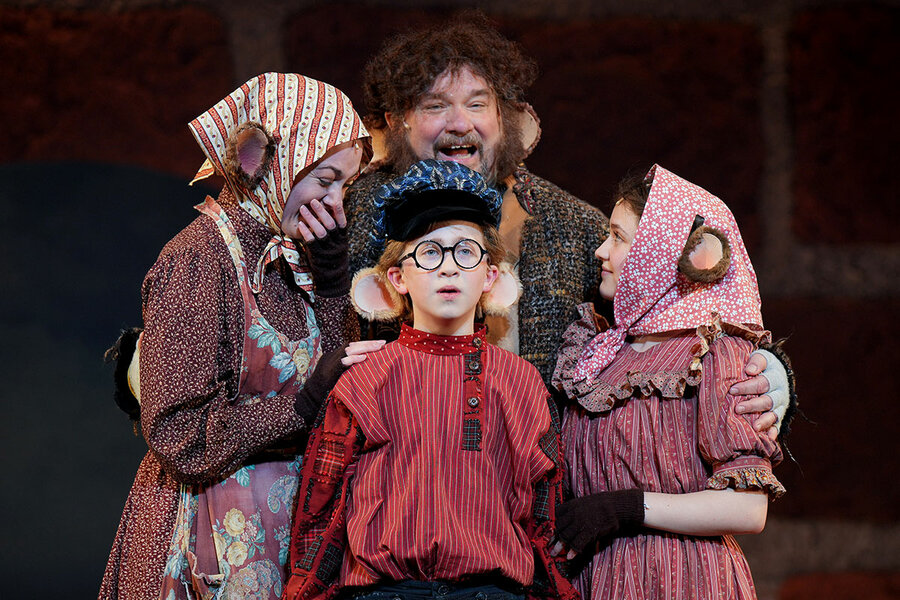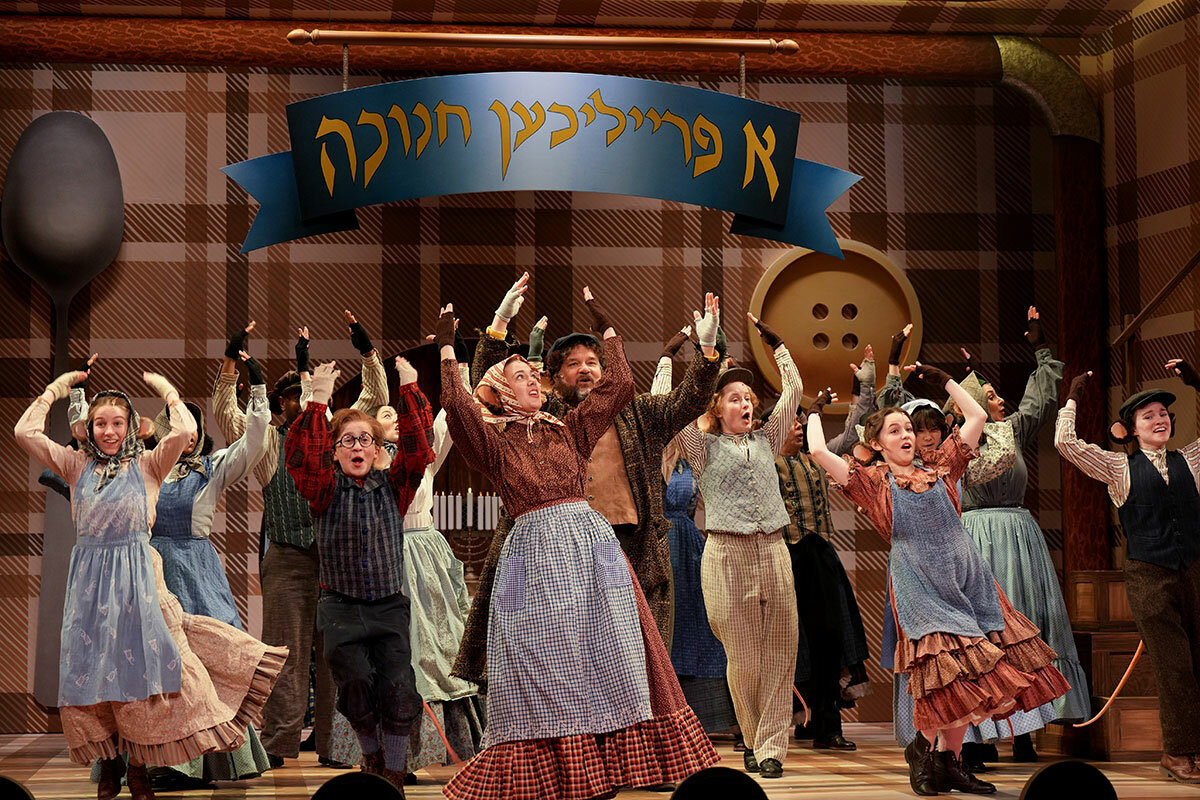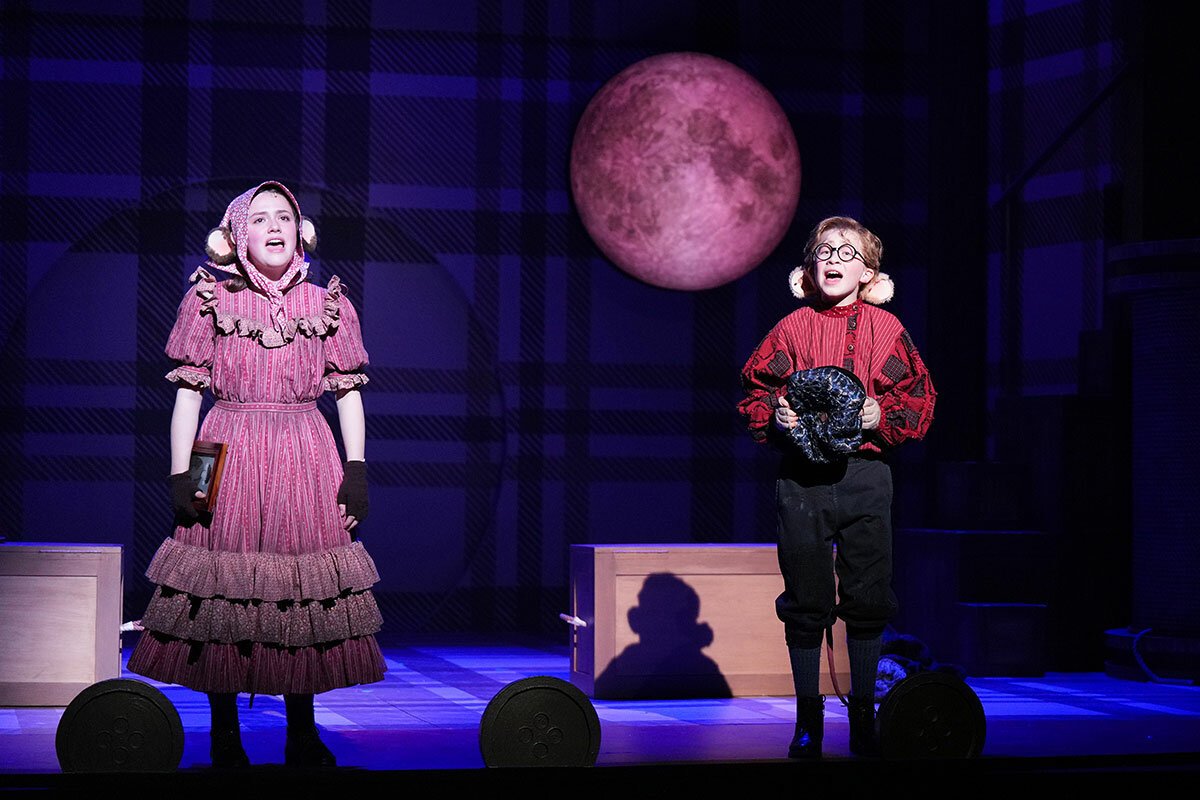Of mice, and men: New ‘An American Tail’ brings Fievel to the stage
Loading...
| Minneapolis
Fievel Mousekewitz’s immigration story begins like so many others – a menacing, outside threat. The packing of bags. A tumultuous voyage at sea.
But, as the name suggests, Fievel isn’t a person, he’s a mouse. And the threat is a band of cats.
Fievel’s tale – “An American Tail” – is a story of loss, hope, rebuilding, and family. It is a story shared by many Americans, some recently, some in generations past.
Why We Wrote This
A story focused onGenerations of American kids grew up on the story of Fievel Mousekewitz. At a time when roughly a quarter of Americans are satisfied with immigration levels, a new play looks at what it means to come to America.
Now, the Children’s Theatre Company in Minneapolis is revisiting the 1986 film classic in dramatic form, in a world premiere from Tony-winning playwright Itamar Moses and Obie-winning director Taibi Magar. The tale of Fievel and his Jewish family’s traumatic uprooting from 19th-century Russia – in what is now Ukraine – to the boroughs of New York City is one that members of Generation X will remember from the animated film and a new generation can learn from.
In the opening act, the family of mice sing, “There are no cats in America, and the streets are paved with cheese!” The puns are abundant, but the lessons are universal.
“America is a patchwork of arrivals, but how do we welcome each new wave?” says Mr. Moses in an interview. “There are threats. But if we can work together, a better version of ourselves is always somewhere out there.”
Ultimately, “An American Tail” harks back to an era when immigration was romanticized, not politicized, in films like “West Side Story” (1961) or “Coming to America” (1988). This February, a Gallup Poll showed that Americans’ satisfaction with the country’s level of immigration had dropped to 28%, its lowest in a decade.
“This is reaching back to a happier time, a vision of immigration when it was seen simply as a part of the way this country worked,” says David Itzkowitz, a St. Paul-based historian. “Now, antisemitism is back in the media. ... Immigration has become a race issue.”
“We mostly all have immigrant stories”
The play begins inside a suitcase, with the Mousekewitz family of Ukrainian Jews singing around a menorah on Hanukkah. It’s here that Papa Mousekewitz (played by Luverne Seifert) offers the famous floppy hat many will remember from the film version to Fievel (Matthew Woody), which will follow his son throughout his early days in America.
It doesn’t take long before giant fluorescent cat eyes – the metaphoric Russian Cossacks – overpower the stage, filling with dry ice, and the Mousekewitzes’ decision is made: They’re escaping to America.
Fievel gets lost at sea and finds himself in a new world all alone, with nothing but that floppy hat. When he runs into Warren T. Rat (Luverne Seifert in a double role), Fievel is tricked into working in a clothing factory with other child mice. He soon meets Tony, an Italian immigrant (Ryan London Levin), and union leader Bridget (Kiko Laureano), who convince Fievel to stand up for his rights while also helping him reunite with his family.
While young people in the audience may not pick up on references like “Frederick Doormouse,” “The Great Compromouse,” or Bridget’s speeches atop a wooden block that literally says “soapbox,” the underlying themes come through.
“Whether [young spectators] will know about child forced separation at the border or not is questionable ... but theater has an inherent pedagogical function,” says Beth Cleary, a retired theater and dance professor at Macalester College in St Paul. “For kids, their major concerns are belonging, lostness, difference. Who am I, do I fit in, am I different? We see someone we identify with in the characters, and make our own stories along with the stories on stage.”
Both Mr. Moses and Ms. Magar drew from personal experience to craft the production, which the Children’s Theatre Company approached Mr. Moses about after acquiring the stage rights. His parents were Jewish immigrants, and Ms. Magar’s Egyptian father sneaked onto a ship in Alexandria before jumping into the water and swimming to Lebanon’s shores.
“Other than Native and enslaved people, we mostly all have immigrant stories,” says Ms. Magar. For this reason, the duo included more immigrant communities of color in the production, such as from African countries and China (Monica Xiong, who plays Qiujin, speaks Chinese throughout the play). “The film version had a narrower lens at the time, but we really wanted kids and parents to see themselves represented.”
It was an equally powerful experience, for both Mr. Moses and several cast members, to showcase a story that puts a Jewish family in a protagonist role. Michael and Liz Hochman say that their daughter Lillian, who plays Fievel’s sister Tanya, often came home after rehearsals and asked about her Jewish heritage. Both parents’ families immigrated to America from Eastern Europe.
“When she sings in Hebrew at the beginning of the play, it’s emotional for me,” says Mr. Hochman after opening night. “I usually have my crying towel with me for shows. Today I had three.”
Never lose hope
In the second act, as Fievel struggles to get away from Warren T. Rat – who turns out to be not a rat at all but something far worse – the Mousekewitz family never loses hope of finding their son. But their dream of a better life is dwindling and, as they soon discover, the streets here are not paved with cheese.
“I can’t believe I brought you to this terrible place where you lose your children!” says Papa to his wife and daughter.
Soon, the streets are in chaos, with unionized and nonunionized mice fighting against one another.
“Who are you going to believe, me or your own eyes?” asks a menacing Warren T. Rat.
But Tony asks the mice who have now banded together, “What if we all told our stories?” Bridget backs him up: “United, there’s nothing we can’t do!”
These are the lessons, say parents in the audience, that their children can grasp – if they haven’t internalized them already.
“My daughter sees it every day, that not everyone in America looks like the [Cleavers],” says Brian Mojica, who immigrated to America at age 14 from the Philippines and whose daughter Ines is part of the ensemble cast. “There’s lots of diversity here, so this is old hat for her. She’s probably thinking, ‘It’s you older people who need to learn.’”
As Fievel is reunited with his family, he realizes that there are, in fact, cats in America and perhaps the streets aren’t paved with gold or cheese. But it still holds the promise of a better tomorrow for the Mousekewitzes.
“America,” says Papa Mousekewitz, hugging his family, “what a place!”








